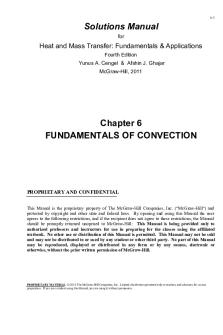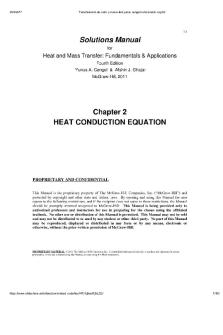Capitulo 08 solucionario transferencia calor y masa cengel 4th ed PDF

| Title | Capitulo 08 solucionario transferencia calor y masa cengel 4th ed |
|---|---|
| Author | Luis Torres |
| Course | Fenómenos de transporte II |
| Institution | Instituto Tecnológico de Morelia |
| Pages | 97 |
| File Size | 3 MB |
| File Type | |
| Total Downloads | 406 |
| Total Views | 683 |
Summary
8-1 Solutions Manual for Heat and Mass Transfer: Fundamentals & Applications Fourth Edition Yunus A. Cengel & Afshin J. Ghajar McGraw-Hill, 2011 Chapter 8 INTERNAL FORCED CONVECTION PROPRIETARY AND CONFIDENTIAL This Manual is the proprietary property of The McGraw-Hil...
Description
8-1
Solutions Manual for
Heat and Mass Transfer: Fundamentals & Applications Fourth Edition Yunus A. Cengel & Afshin J. Ghajar McGraw-Hill, 2011
Chapter 8 INTERNAL FORCED CONVECTION
PROPRIETARY AND CONFIDENTIAL This Manual is the proprietary property of The McGraw-Hill Companies, Inc. (“McGraw-Hill”) and protected by copyright and other state and federal laws. By opening and using this Manual the user agrees to the following restrictions, and if the recipient does not agree to these restrictions, the Manual should be promptly returned unopened to McGraw-Hill: This Manual is being provided only to authorized professors and instructors for use in preparing for the classes using the affiliated textbook. No other use or distribution of this Manual is permitted. This Manual may not be sold and may not be distributed to or used by any student or other third party. No part of this Manual may be reproduced, displayed or distributed in any form or by any means, electronic or otherwise, without the prior written permission of McGraw-Hill.
PROPRIETARY MATERIAL. © 2011 The McGraw-Hill Companies, Inc. Limited distribution permitted only to teachers and educators for course preparation. If you are a student using this Manual, you are using it without permission.
8-2
General Flow Analysis
8-1C Engine oil requires a larger pump because of its much larger density.
8-2C The generally accepted value of the Reynolds number above which the flow in a smooth pipe is turbulent is 4000.
8-3C For flow through non-circular tubes, the Reynolds number as well as the Nusselt number and the friction factor are 4 Ac based on the hydraulic diameter Dh defined as D h = where Ac is the cross-sectional area of the tube and p is its p perimeter. The hydraulic diameter is defined such that it reduces to ordinary diameter D for circular tubes since 4A 4πD 2 / 4 = D. Dh = c = πD p
8-4C The hydrodynamic and thermal entry lengths are given as Lh = 0.05 Re D and Lt = 0.05 Re Pr D for laminar flow, and L h ≈ Lt ≈ 10 D in turbulent flow. Noting that Pr >> 1 for oils, the thermal entry length is larger than the hydrodynamic entry length in laminar flow. In turbulent, the hydrodynamic and thermal entry lengths are independent of Re or Pr numbers, and are comparable in magnitude.
8-5C The friction factor is highest at the tube inlet where the thickness of the boundary layer is zero, and decreases gradually to the fully developed value. The same is true for turbulent flow.
8-6C In turbulent flow, the tubes with rough surfaces have much higher friction factors than the tubes with smooth surfaces. In the case of laminar flow, the effect of surface roughness on the friction factor is negligible.
8-7C The friction factor f remains constant along the flow direction in the fully developed region in both laminar and turbulent flow.
8-8C The fluid viscosity is responsible for the development of the velocity boundary layer. For the idealized inviscid fluids (fluids with zero viscosity), there will be no velocity boundary layer.
PROPRIETARY MATERIAL. © 2011 The McGraw-Hill Companies, Inc. Limited distribution permitted only to teachers and educators for course preparation. If you are a student using this Manual, you are using it without permission.
8-3
8-9C The number of transfer units NTU is a measure of the heat transfer area and effectiveness of a heat transfer system. A small value of NTU (NTU < 5) indicates more opportunities for heat transfer whereas a large NTU value (NTU >5) indicates that heat transfer will not increase no matter how much we extend the length of the tube.
8-10C The hydrodynamic and thermal entry lengths are given as Lh = 0.05 Re D and Lt = 0.05 Re Pr D for laminar flow, and L h ≈ Lt ≈ 10 D in turbulent flow. Noting that Pr...
Similar Free PDFs
Popular Institutions
- Tinajero National High School - Annex
- Politeknik Caltex Riau
- Yokohama City University
- SGT University
- University of Al-Qadisiyah
- Divine Word College of Vigan
- Techniek College Rotterdam
- Universidade de Santiago
- Universiti Teknologi MARA Cawangan Johor Kampus Pasir Gudang
- Poltekkes Kemenkes Yogyakarta
- Baguio City National High School
- Colegio san marcos
- preparatoria uno
- Centro de Bachillerato Tecnológico Industrial y de Servicios No. 107
- Dalian Maritime University
- Quang Trung Secondary School
- Colegio Tecnológico en Informática
- Corporación Regional de Educación Superior
- Grupo CEDVA
- Dar Al Uloom University
- Centro de Estudios Preuniversitarios de la Universidad Nacional de Ingeniería
- 上智大学
- Aakash International School, Nuna Majara
- San Felipe Neri Catholic School
- Kang Chiao International School - New Taipei City
- Misamis Occidental National High School
- Institución Educativa Escuela Normal Juan Ladrilleros
- Kolehiyo ng Pantukan
- Batanes State College
- Instituto Continental
- Sekolah Menengah Kejuruan Kesehatan Kaltara (Tarakan)
- Colegio de La Inmaculada Concepcion - Cebu















